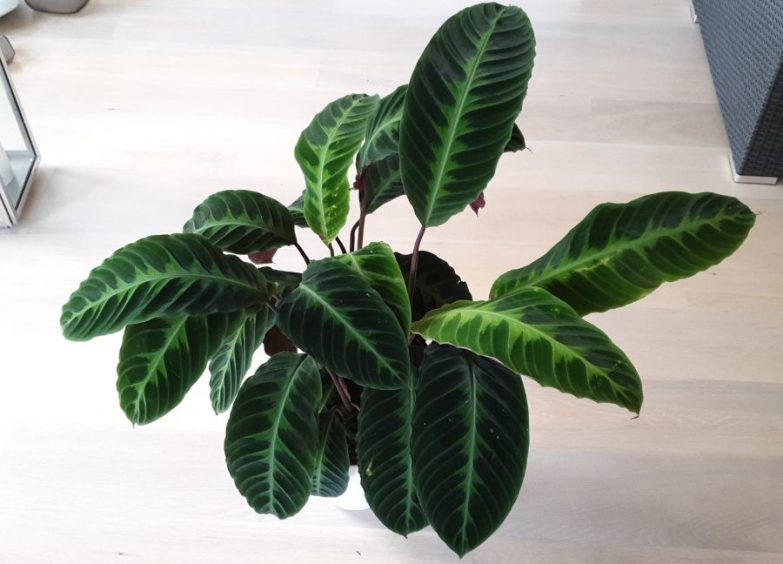It just takes one look at the eye-catching and elaborate foliage to realize why Calatheas are such popular houseplants. Best of all, there are so many Calathea varieties to choose from, each with their own uniquely colored foliage to fall in love with.
Calathea Varieties
Regardless of the variety, all Calatheas require similar care for healthy and problem-free growth. Grow in rich, well-draining soil kept evenly moist, create moderate to high humidity, grow in a warm environment with bright indirect light, and feed monthly.
It’s easy to fall in love with Calatheas and their exotic foliage, so don’t be surprised if you can’t resist their vibrant and exotic beauty. My own collection started with just one and that soon spiraled out of control.
Whilst many of the more common Calatheas on this list are widely available and easy to find, some of the more unusual varieties are best purchased online. I personally buy many of my houseplants on Etsy (link to Etsy). Let’s look at 12 of my favorite Calathea varieties that I know you will love.
Calathea Orbifolia
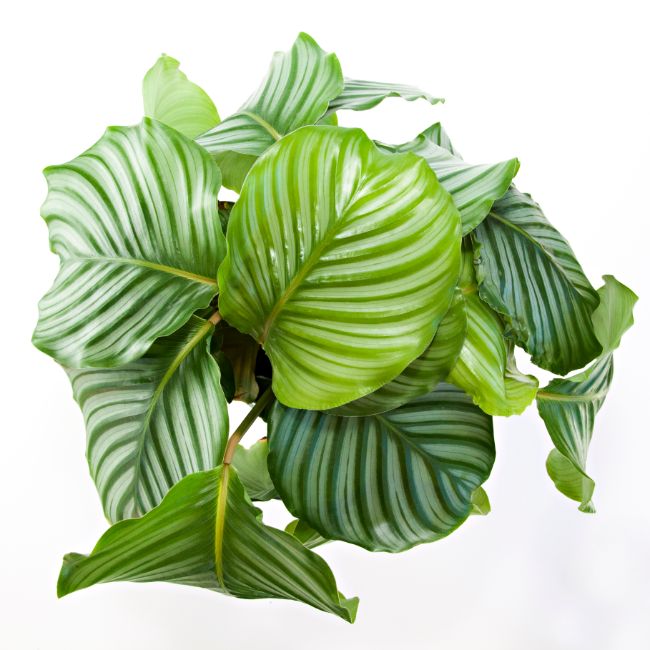
If you’re looking for a Calathea to make a bold statement, then Calathea orbifolia could be the gem for you. Calathea orbifolia is sure to grab your attention with its large robust leaves donning their almost metallic pattern.
The green leaves streaked in silver are round and leathery, growing almost 12 inches wide, with mature plants growing around 2.5 feet tall and wide. Calathea orbifolia forms into thick plants, with new growth forming from the plant’s center. It’s sure to bring a tropical feeling to your home.
Like all Calathea varieties, Calathea orbifolia performs best in a warm indoor environment with temperatures ranging between 65°F to 80°F. It can suffer damage when temperatures dip below much below 60°F. To keep it thriving, grow in a uniformly moist (not soggy), rich soil that drains well. Create high humidity to prevent leaf curling or brown edges.
Keep your Calathea away from cold drafty locations. In addition, bright filtered light will produce the best growth and leaf color, as too little light results in leggy plants and too much direct sunlight burns the foliage.
Sensitive to salt like all Calatheas, fertilize no more than monthly during the growing season using a half-strength, water-soluble houseplant fertilizer. In addition, flush the soil periodically to remove any fertilizer salt buildup.
If you are struggling to find any of the Calatheas on this list locally, I’d highly recommend buying your houseplants on Etsy. It’s where I buy most of my houseplants now, and I’ve had great experiences so far.
Calathea Warscewiczii
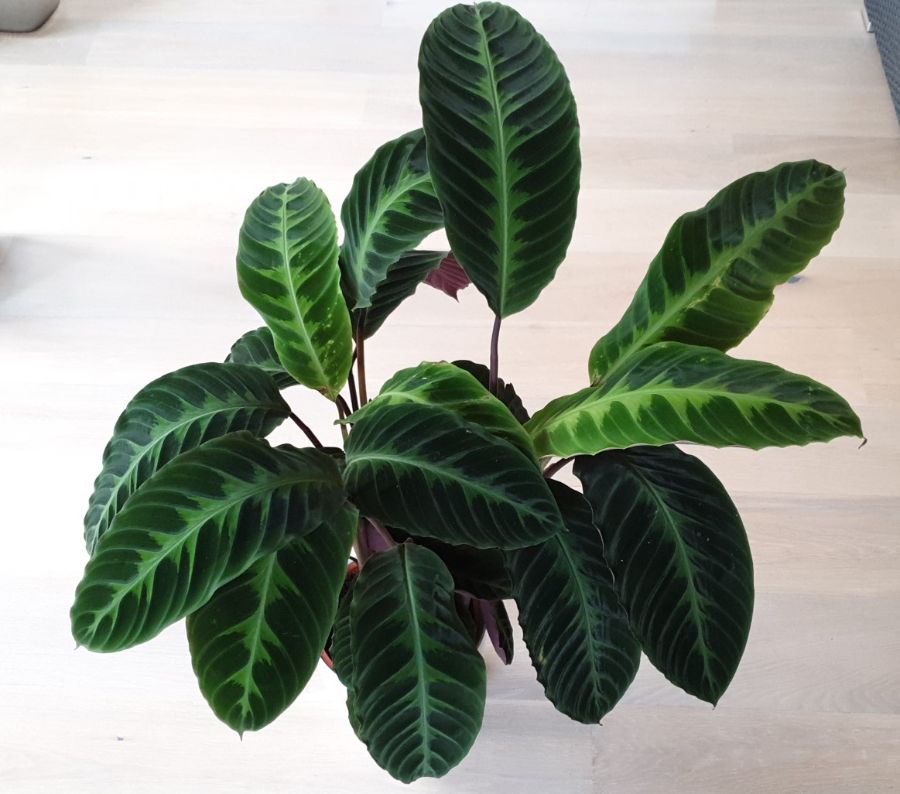
Native to Costa Rica and Nicaragua, Calathea warscewiczii is considered a tender herbaceous perennial evergreen. It’s one of the more popular varieties of Calathea and an absolute favorite of mine. Named after the heroic polish botanist, Józef Warszewicz, it has a name that I’ve tried and failed to pronounce for several years. Thankfully it is also known as Calathea Jungle Velvet – a perfect moniker for this delightful plant.
The lance-shaped velvety and dark green leaves have distinct banding in a lighter green that forms into a fishtail pattern, with the undersides a rich purple. In the evening, the leaves fold close like another relative in their family Prayer Plants.
Each leaf grows around 12 inches tall, with the plant growing up to 3 feet tall at maturity with a clumping habit. During winter and late spring, tall spikes fill with white flower bracts that last three to four weeks.
When it comes to Calathea warscewiczii care, grow in a uniformly moist (not soggy), rich soil base that drains well and where indoor temperatures range between 65°F to 80°F and create high humidity by grouping your plants, placing them on a humidity tray or using a humidifier.
Keep away from cold and drafty locations and provide bright filtered light. Too little light results in leggy plants and too much direct sunlight scorches the foliage, and it loses its color.
Calathea warscewiczii is susceptible to fertilizer salt burns, so feed monthly during the growing season with a water-soluble houseplant blend applied at half-strength and flush the soil to remove salt buildup every few months.
Calathea Makoyana
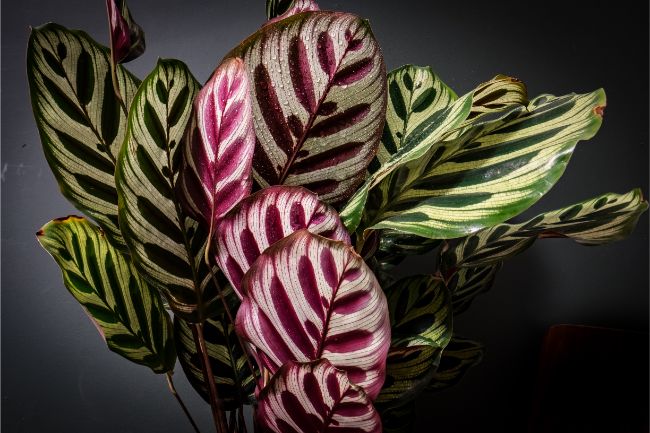
Calathea makoyana is commonly known as Peacock Plant or Cathedral Windows and the elaborate and colorful markings on the egg-shaped foliage explains why. The papery thin leaves with purple undersides are light green with dark green peacock markings surrounded by cream feathering and grow up to 12 inches long.
Each leaf is attached to a reddish-pink stem and newly formed leaves are rolled highlighting their purple undersides. This brings even more color to this low-growing and compact plant, which matures to around 12 inches tall. White insignificant flowers forming in spring, though houseplants rarely flower.
To provide good Calathea makoyana care, grow in a fertile potting mix with good drainage and keep the soil evenly moist. High humidity and temperatures between 60°F and 75°F are preferred and keep the Calathea out of areas with cold drafts.
When it comes to feeding, Calathea makoyana is sensitive to salt like all Calatheas. Feed monthly with a water-soluble houseplant blend at half-strength and periodically flush the soil of salt buildup.
Read my article about Calathea Makoyana care for more detail on how to look after this beautiful plant. I also cover how to prevent some of the common problems.
Calathea Crocata
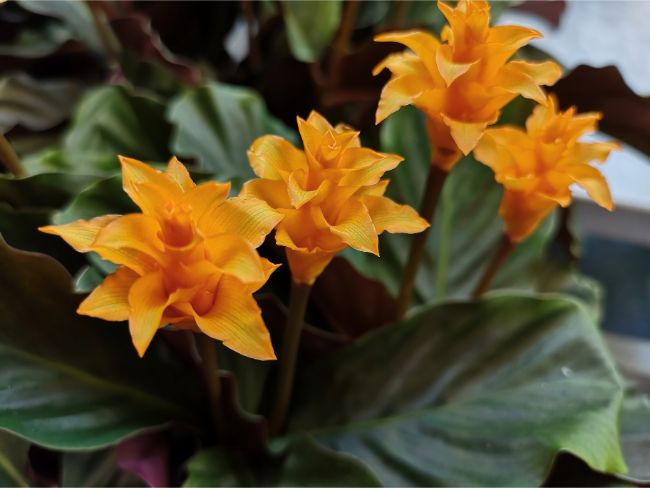
A relatively new Calathea making its way on the houseplant scene is Calathea crocata. Also known as Eternal Flame due to the eye-catching and robustly bright flowers. Sadly, this tropical native to the jungles of Brazil is getting harder to find in the wild due to environmental damage.
The stunning flowers resemble flames in colors of bright orange or yellow, rising on spikes and mingling among the wavy spear-shaped leaves. Each bloom offers two to three months of long-lasting color. However, once the flowers fade the dark green metallic foliage puts on an attractive show of its own. Mature plants average 1 to 2 feet tall and wide.
When it comes to Calathea crocata’s preferred environment, this particular Calathea likes it warm and humid. You will get the best performance growing it in a room with stable temperatures of 65°F to 80°F and high humidity. Try one of these methods to boost humidity in your home if needed.
To promote healthy growth, grow Calathea crocata in well-drained fertile soil kept moist through regular watering. However, don’t keep the soil soggy. Although a heat-lover, Calathea crocata doesn’t tolerate full sun. Situate indoors in a location with bright to medium indirect sunlight. Additionally, fertilize monthly during active growth using a water-soluble houseplant blend applied at half-strength.
With stunning blooms and elegant foliage, I find this calathea hard to resist. Read my complete guide to calathea crocata care to get up to speed on everything you need to know.
Calathea Ornata
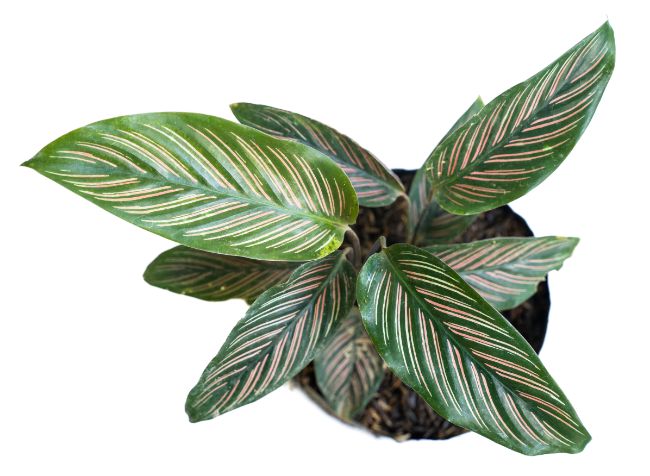
One look at the ornately striped leaves and it’s easy to see why it received its common name, the Pin-Stripe Plant. Hailing from Columbia and Ecuador, Calathea ornata is a popular variety of Calathea typically seen as a houseplant.
The dark green and glossy oblong leaves with purple undersides are attached to long green stems. However, it’s the pinkish-white pin stripes forming a feathery pattern on the leaves that puts on the biggest show. Additionally, the leaves can grow over a foot long. Calathea ornata has a clumping habit typically averaging around 2 feet tall and wide and is sure to add a tropical feel wherever placed.
Care requirements are similar to other calathea species, so plant in a fertile, well-drained potting mix kept consistently moist through regular watering. Place where indoors temperatures range between 65°F and 80°F and create high humidity using one of these great methods.
Bright filtered light is best, as direct sun results in foliage color loss and possible burning and too little light slows growth. During the growing season, feed monthly using a half-strength water-soluble houseplant blend. Periodically flush the soil to remove the buildup of fertilizer salts.
If you’d like to read more about calathea ornata, I’ve written an entire article about this dazzling beauty. It’s best to read up before bringing this plant home, as they can be a little fussy if they don’t get just what they need.
Calathea Zebrina
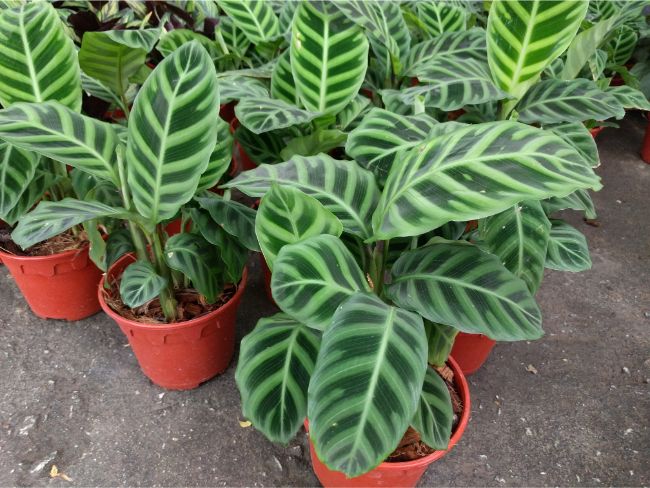
A tropical perennial native to southeastern Brazil, Calathea zebrina, also called the Zebra Plant is easier to locate than some Calathea varieties. The striking light green and velvety leaves with purple undersides earn their common name due to the dark green stripes running across them resembling a Zebra.
Each leaf can grow over 12 inches tall, folding at night and mature plants can grow over 2 feet wide and tall. Although Calatheas rarely bloom as houseplants, Calathea zebrina produces insignificant whitish-purple flowers in spring.
Keep your Calathea zebrina healthy by growing it in moist, fertile soil with good drainage and where indoor temperatures range between 65°F to 80°F and place away from drafty and cold locations.
In addition, bright filtered light produces the best growth. Too little light results in leggy plants and too much direct sunlight results in the leaves losing their color and possible burns.
Maintain high humidity and feed monthly during the growing season using a half-strength water-soluble houseplant blend. Sensitive to salt burns, flush the soil periodically to remove any buildup.
Calathea Lancifolia
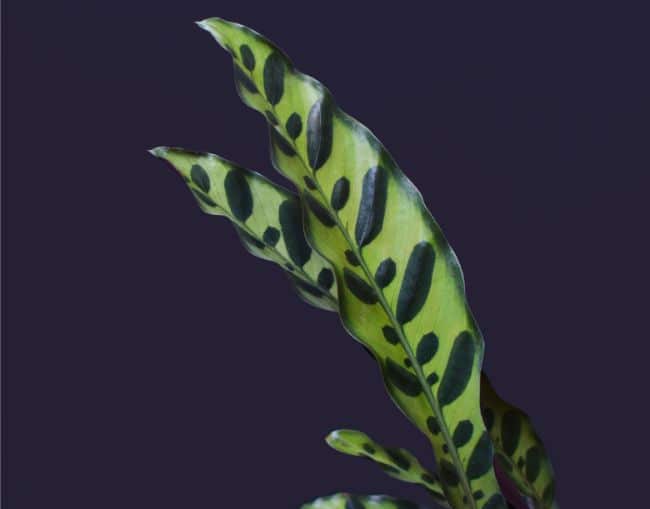
Calathea lancifolia is better known as the Rattlesnake Plant due to the unique markings on the foliage resembling the reptile. This is a taller variety of Calathea, with mature plants growing around 18 inches tall. The long lance-like and glossy leaves are wavy and pale to yellowish-green on top, with purple undersides.
Both sides of the leaves are spotted with various dark green blotches. When grown indoors, Calathea lancifolia rarely blooms, however, in springtime yellow flowers bloom on 4-inch spikes, but you won’t miss the flowers with the plant’s attractive foliage.
Keep your Rattlesnake Plant healthy by planting in a rich, well-drained potting mix kept moist, but not soggy, especially during the growing season. Provide indoor temperatures of between 65°F and 75°F and bright filtered light, avoiding direct sunlight.
Additionally, ensure you provide plenty of humidity and feed monthly during the growing season using a half-strength water-soluble houseplant blend. Flush the soil periodically to remove any salt buildup.
Calathea Rufibarba
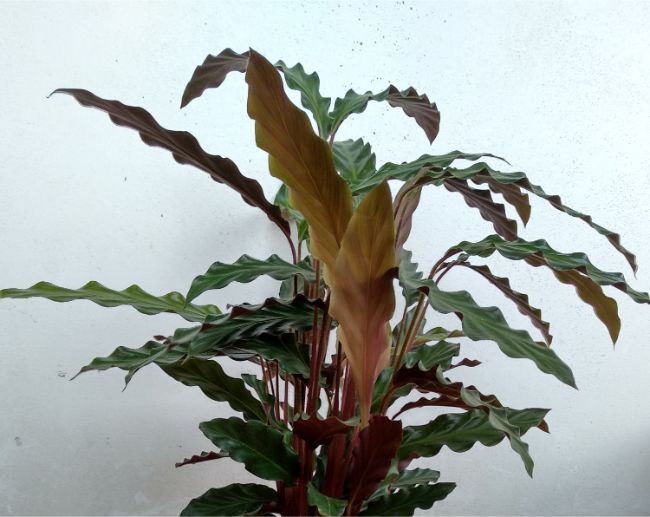
Although its foliage might not be as elaborately marked and colored like some Calathea varieties, Calathea rufibarba is still a beauty offering indoor tropical appeal. Its common name is Velvet Calathea or Furry Feather, due to the fur-like texture of the leaf undersides.
This Brazilian native has an upright clumping form with semi-glossy spear-like foliage that is green on top and burgundy underneath. The leaves have long burgundy stems and plants can grow 2 to 3 feet tall with a similar width.
Calathea rufibarba prefers a warm indoor environment with temperatures between 65°F and 80°F and out of cold drafts. For the best growth and leaf coloration, situate in bright filtered or indirect light and not in direct sun. Additionally, grow in fertile soil that drains well and kept consistently moist but not soggy, especially during active growth.
Like most Calatheas, Calathea rufibarba has high humidity requirements. It should be fertilized monthly with a half-strength blend of a water-soluble houseplant formula. Remember to periodically flush the soil to remove any salt buildup.
Calathea Roseopicta
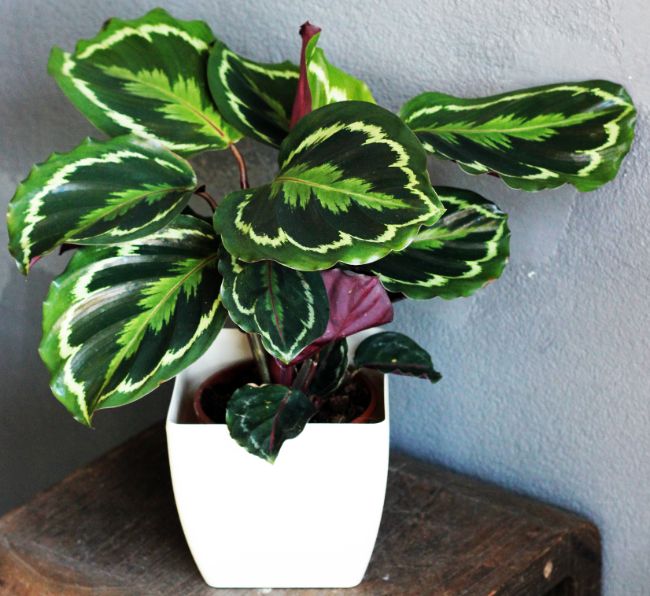
Calathea roseopicta, also called Rose Painted Calathea, certainly earns its name with striking foliage and bright patterns. It’s all about the large oval and glossy leaves that are green on top and purple on the bottom. Each leaf has a distinctive pattern that looks like the outline of a smaller leaf.
Calathea roseopicta has a bunching habit and plants average around 20 inches tall and wide. In addition, there’s numerous cultivars available with differing leaf colors and patterns.
To keep your plant in great shape, grow Calathea roseopicta in a uniformly moist, rich soil base that drains well. Keep indoor temperatures between 65°F to 80°F and keep it away from cold drafty locations.
Bright filtered light produces the best leaf color and growth. Too little light results in leggy plants and too much direct sunlight scorches the foliage. Feed monthly during the growing season with a half-strength blend of a water-soluble houseplant blend. Flush the soil periodically to remove any salt buildup and create humidity by misting several times weekly.
Calathea Roseopicta ‘Dottie’
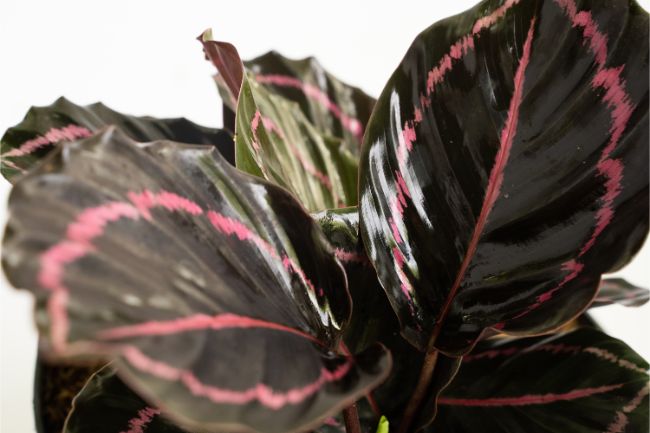
Calathea roseopicta ‘Dottie’ is a cultivar or variety bred from Calathea roseopicta (noted above). Like its mother plant – it’s all about the large, glossy foliage. The leaves are sure to be eye-catching with their oval shape colored in a deep greenish-black making them look almost black.
To set them off even more, each leaf is outlined in a bright almost fuchsia pink. This stretches down the center leaf margin and resembling the pink outline of another leaf. Like its mother, the bunching plants average around 20 inches tall and wide at maturity. Calathea roseopicta ‘Dottie’ has the same care requirements as Calathea roseopicta.
Calathea Roseopicta ‘Rosey’
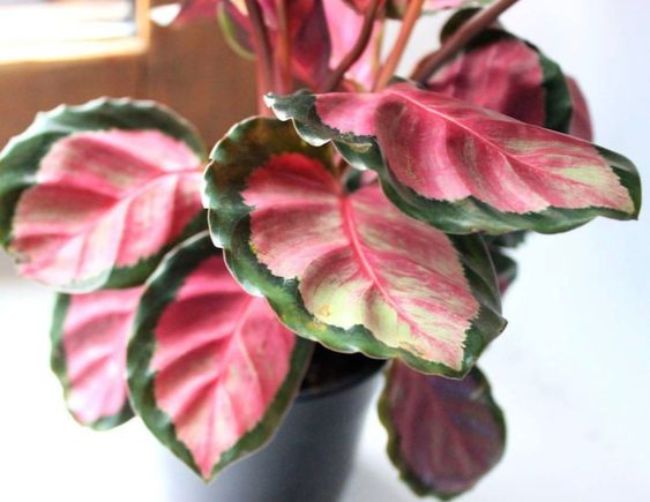
Another delightfully colorful and popular cultivar of Calathea roseopicta is ‘Rosey’. The clump-forming evergreen boasts large oval leaves bordered in green with cream and pink colored centers and a pink feather pattern in the center. If that wasn’t enough color going on, the underside of the foliage is purple and the leaves fold at nighttime.
Mature plants can grow up to 20 inches tall, but are usually a bit smaller. Calathea roseopicta ‘Rosey’ is sure to add a blast of color and grab attention wherever placed indoors. ‘Rosey’ has the same care requirements as its parent Calathea roseopicta discussed above.
Calathea Ornata ‘Sanderiana’
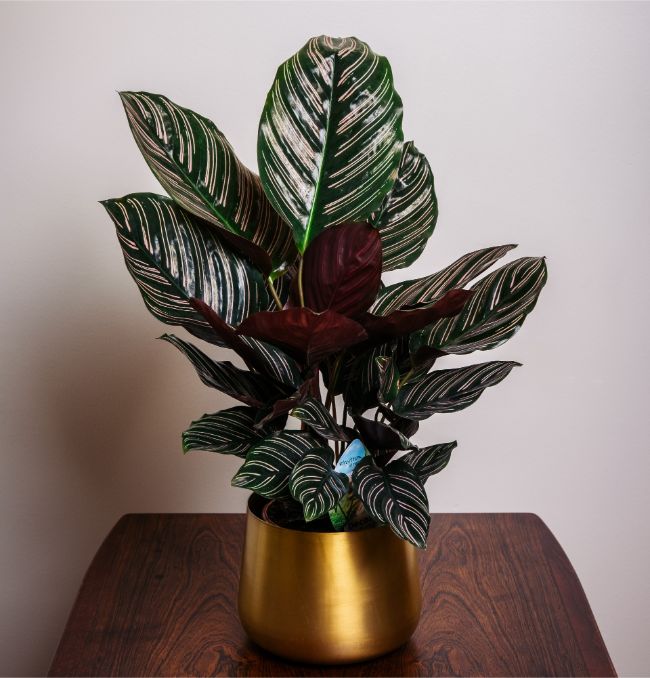
Calathea ornata ‘Sanderiana’ is a cultivar or variety bred from Calathea ornata. Like its mother plant, ‘Sanderiana’ also goes by the common name Pin Stripe plant due to the striping of the foliage. The basic difference between the two is the leaves on Sanderiana are not as long and are more elliptical than spear-like.
This Calathea is sure to add a tropical and colorful feeling with its broad leathery and glossy leaves. They sport dark green on top with feathery pinstripes tinged in rose and cream, with the undersides dark purple. The leaves are attached to purple stems and grows to around 2 feet tall and about half as wide at maturity. You can keep it happy and healthy by caring for it as you would its mother, Calathea ornata.
Expert Calathea Care Tips
There’s some basic tips to keep all calathea varieties looking their best and producing healthy growth.
- Do not water with chlorinated water or leaf spotting can occur. Use rain water, bottled or distilled water, or allow your tap water to sit out overnight before using to water or mist for humidity.
- Calatheas require a humid environment, especially during winter. Use one of these methods to keep humidity at an optimum level.
- Keep your Calathea in an environment where temperatures don’t drop below 60 to 65°F. These are tropical plants that require a warm locale.
- Most Calathea varieties are sensitive to fertilizer salts that can burn the leaf tips. Don’t overfertilize and be sure to flush the soil periodically to remove any salt buildup.
All Calathea varieties require consistently moist soil during the growing season and have a low-drought tolerance. However, this doesn’t mean soggy or rot can develop.

